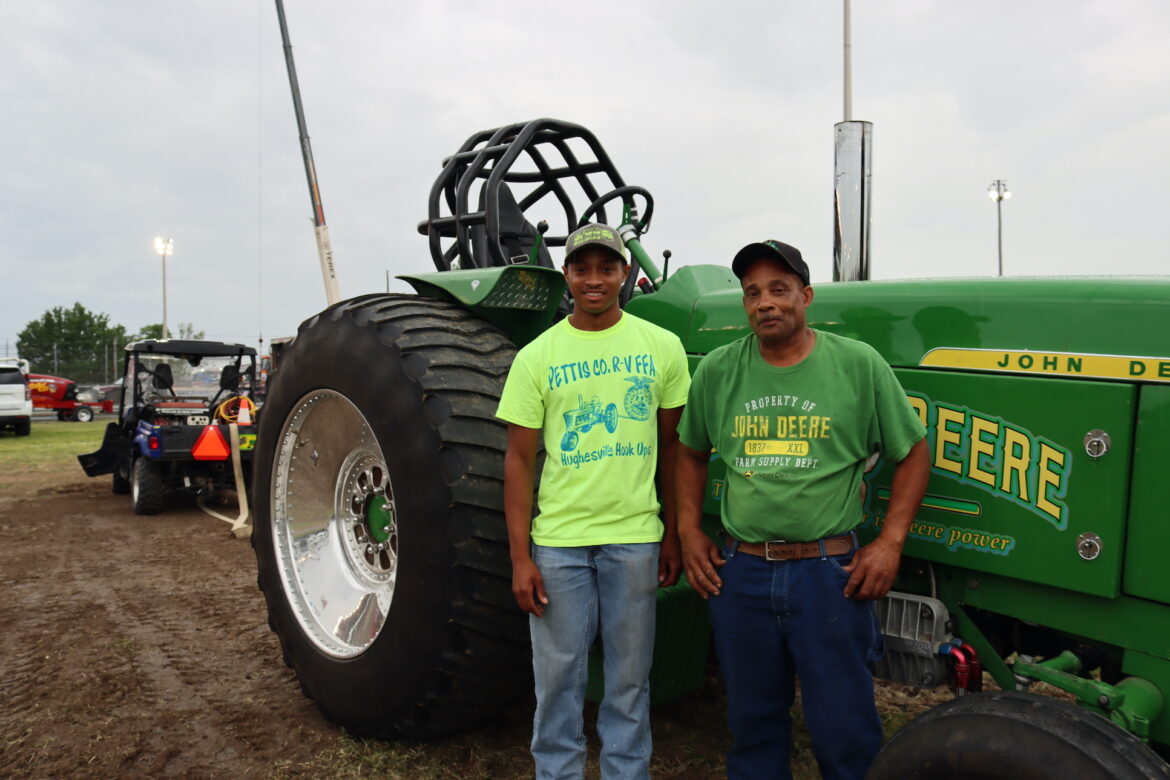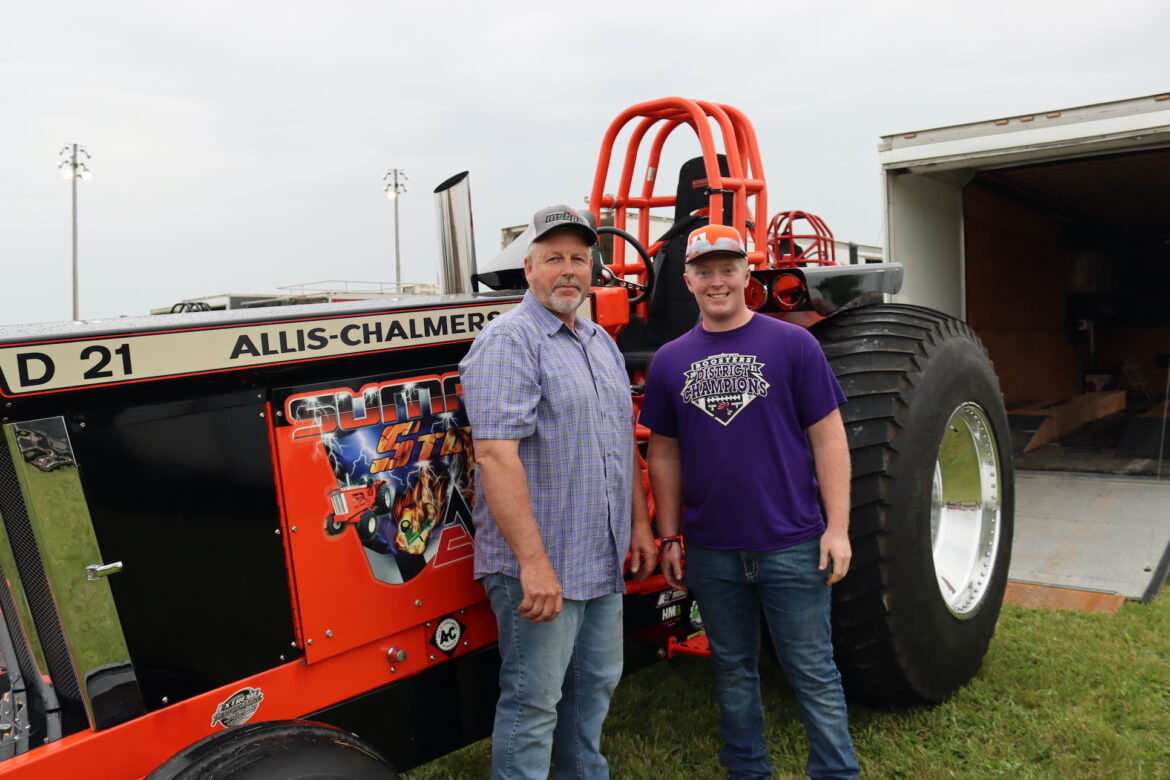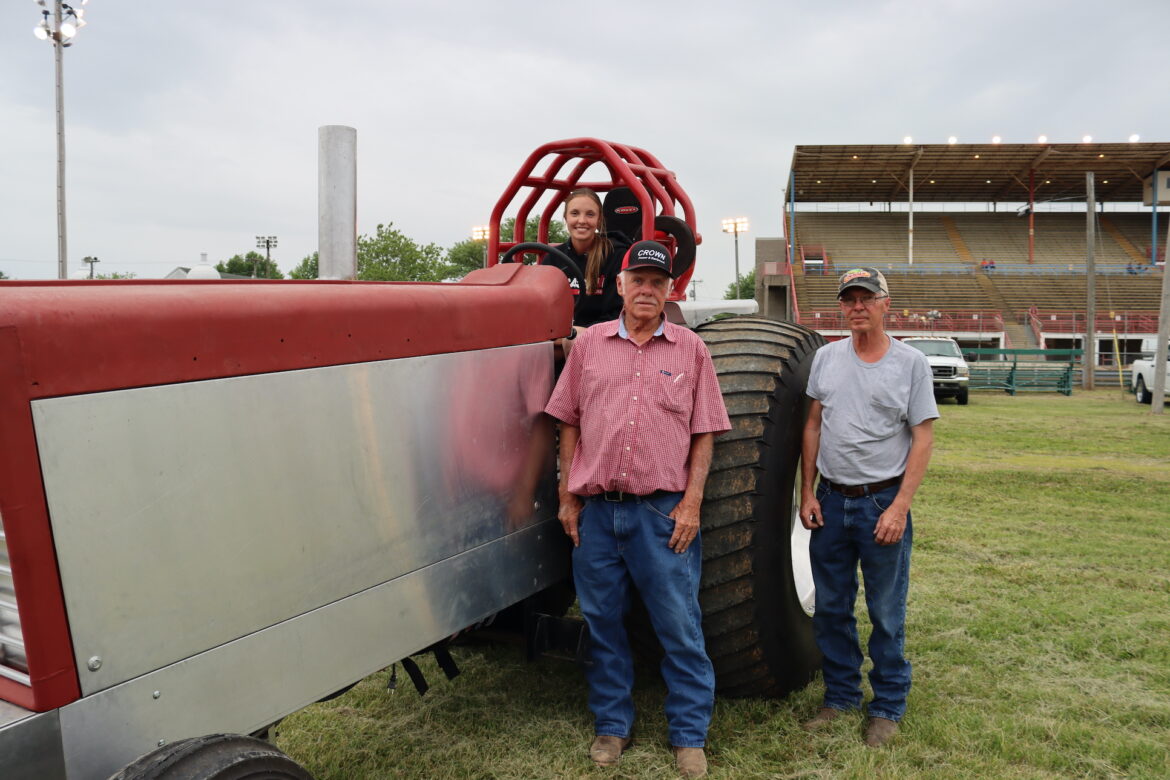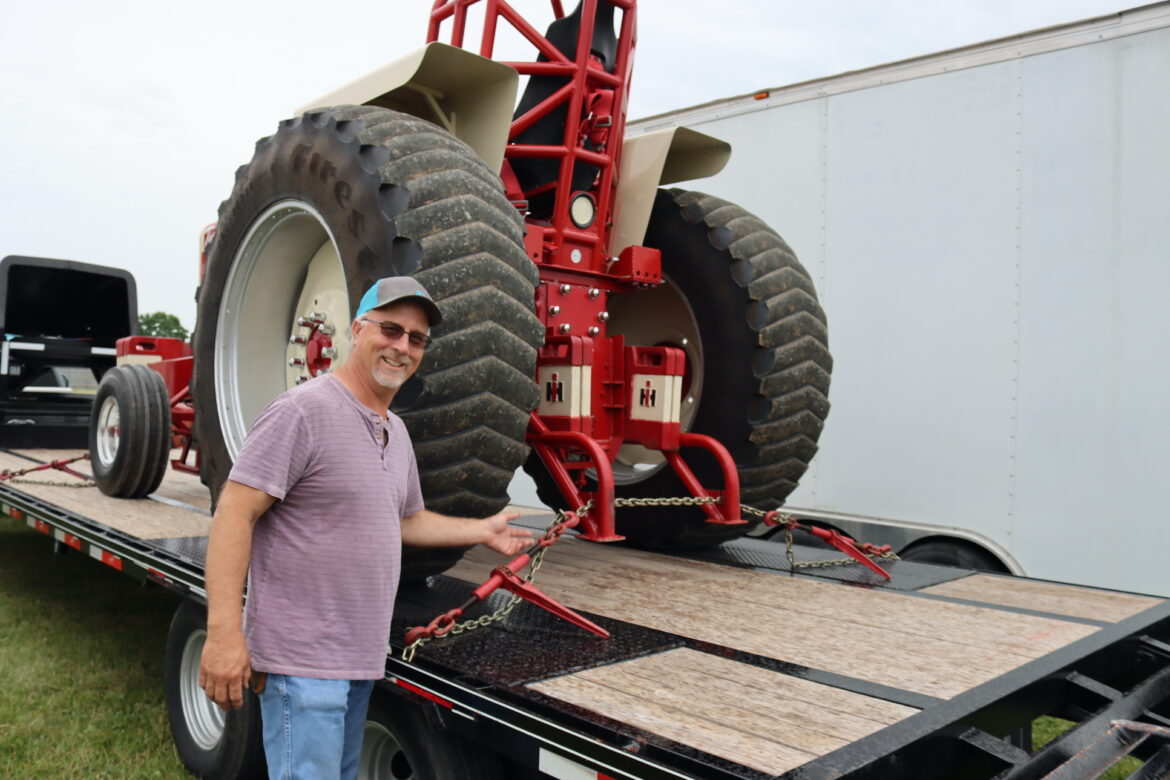Sound, Smoke and Fury: The Enduring Allure of the American Tractor Pull Folks Still Flock for Horsepower Competitions
Published June 16th, 2022 at 6:00 AM
Above image credit: The final day of the Cass County Fair wraps up Sunday night with a tractor pull on the fairgrounds in Pleasant Hill, Missouri. (Cami Koons | Flatland)SEDALIA, Missouri – From metal stadium seats, onlookers hear a motor roar to life. They see a cherry red glow from an exhaust pipe, and smoke billows out of the top.
As front wheels pop off the ground, a tractor lurches forward and a driver bounces in the seat to stay steady.
Seconds later the run is over. The tractor has pulled as far as it can before breaking down or spinning out.
Welcome to a great rural American tradition – a tractor pull.
However gruff the sport may seem from afar, a deeper look at its participants reveals a tradition grounded in friendly competition, family heritage and Midwestern generosity.
“I don’t think you’re gonna find anybody with a bigger heart than a truck or tractor puller,” said long-time puller Darrell Hendrix.
Proud Heritage
Before the advent and popularity of tractors, farmers used horses – often massive Belgians and Clydesdales – to pull equipment through the field. At some point, they started competing with other local farmers to see who had the strongest horses. It was a literal demonstration of “horsepower.”
Tractors gradually replaced horses on most farms in the early 20th century and soon the new machines found their way into friendly competition too.
In fact, Missouri can lay some claim to being the home of the tractor pull. The first known tractor pulls took place in 1929 in Bowling Green, Missouri, and Vaughnsville, Ohio.
In the 1950s and 1960s the sport grew in popularity and continues to have events in agricultural regions across the globe.
Most pullers have been around the sport their whole lives. When they became old enough, they’d take over driving for their dad or grandpa, who still come to the competitions to help with maintenance and support. Some of the older generations still compete as well.
That goes for the fans too.
Three generations of the Blackaby family drove up from Clinton, Missouri, to watch the recent pull in Sedalia.
“We come every chance we get,” Bobby Blackaby said.
It’s one of their favorite family activities, and this one is special as it’s 2-year-old Emmy’s first pull.
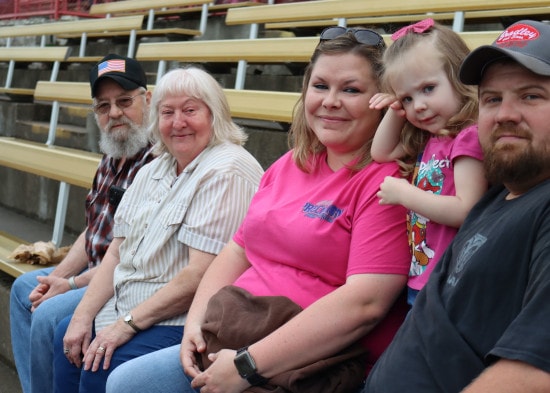
For those like young Emmy who are new to the sport, here’s how it works:
Highly modified tractors and trucks are hooked to a sled. Their drivers, dressed in fire-resistant jumpsuits, bring the motor up to speed and then the tractor (or truck) lurches forward.
As the machine pulls, a mechanism slides from back to front across the sled to make the weight more difficult to pull until eventually the truck or tractor sputters out or can no longer pull the weight.
Usually a puller has one run and only goes a few hundred feet. Top pulls at Sedalia stretched about 350 feet.
Brad Summers, president of Missouri State Tractor Pullers Association (MSTPA), has been pulling for about 45 years. He grew up on a farm, always around tractors, and started pulling at age 15.
“It just gets in your blood,” Summers said.
Back then, he pulled antique tractors, but switched to higher-horsepower tractors as he got older. Antique pulls still occur, but for the most part, the sport has shifted to the higher horsepower machinery that competed in Sedalia last weekend.
Most pullers still come from a farming background, but the tractors they compete with are purely for sport and can’t go back to the farm.
“It’s been altered way too much,” Summers said.
These after-market alterations include adding roll cages to the tops for safety, swapping out parts in favor of lighter versions, and reinforcing the undercarriage. Ultimately, Summers said these machines are really only made to run for about 15-20 seconds before they have to cool off.
Trying to use them on the farm would be impractical.
Because of this, the sport is not very accessible. Buying, maintaining and fueling these tractors isn’t cheap. Summers estimated upkeep alone could run between $5,000 to $10,000 a year.
That’s also why families tend to stick together.
Sawyer Wells took over driving Summers’ tractor last year. He hopes to one day be able to afford his own rig, but right now enjoys pulling with his uncle.
Haylee Schreier is a third-generation puller. She grew up seeing her grandfather and father pull and decided to pick up the sport herself when she could.
Not only does she have a unique relationship with her dad and grandpa, but the rest of the family (her mom and two sisters) comes out to all of the pulls. For the Schreier family, and many others in the sport, summertime memories are built in the grassy pit of a dirt track.
“A lot of people kind of look at it as a redneck sport, but … it’s just always been a fun family thing to do,” Melanie Schreier, Haylee’s mother, said.
The Sims family had an even more unique entrance to the sport.
Arthur Sims III and his father, Arthur Sims II, came to the same tractor pull in Sedalia about 15 years ago as spectators and decided to get into the sport together.
Sims III was only 3 years old at the time. But the two learned the sport together, starting with antique tractors when he was 5, and moving up in machinery to the pro field tractor he pulled on Saturday.
Both pulled John Deere tractors on a recent Saturday in different classes.
“It’s definitely a family thing,” Sims III said.
While he might show up in the same trailer with his dad, that’s far from the only family Sims III has at a pull.
“Aside from the pulling aspect, you feel like a big family here,” Sims III said. “Everyone just gets along.”
Unparalleled Camaraderie
Ask anyone in the pit why they pull and they’ll tell you it’s because of the close friendships they’ve made.
Older pullers like Summers and Hendrix have spent most of their summers together at pulls since they were teenagers.
“If you break down, they’ll jump in to help you … I mean, every one of these guys right here I get along better (with) than my blood family,” Hendrix said.
Young pullers like Sims III, Wells and Haylee Schreier feel just as welcomed to the sport. Older generations are happy to know the activity they love is in good hands.
“I just think they treat me like everyone else, they don’t make me feel like I’m a weird one out or anything like that,” said Schreier, who is one of the few women in the sport.
Jaxson Prough, a young puller of only 20 years old, echoed the sentiment and said he’s had no trouble joining the Missouri pulling family.
“It’s really cool to pull against somebody that’s three times your age,” Prough said. “You get to learn a lot from them because they’ve been around the sport a lot longer.”
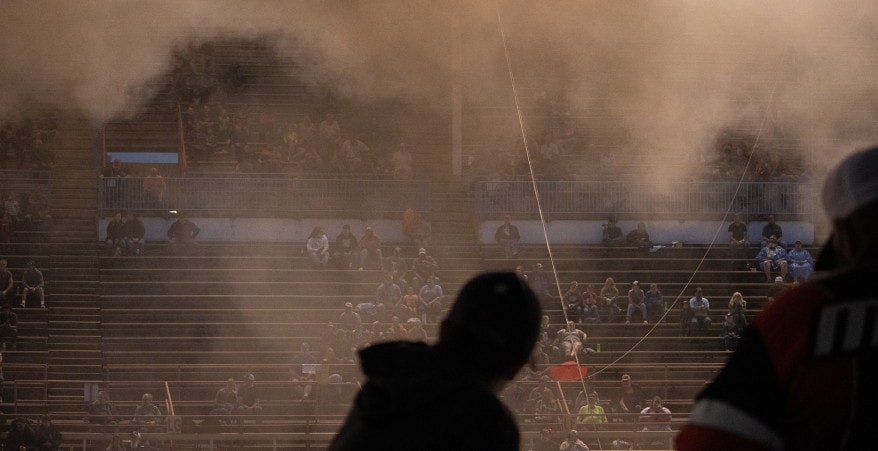
While walking around the pit, pullers would stop to welcome other pullers, poking fun at one another while sporting big smiles.
There’s competition while hooked to the sled, but outside of those 15-20 seconds, John Deere owners clap the backs of those who pull International brand tractors and truck pullers, like Mike McCoy, get along with tractor pullers like siblings.
“This is what it is about the sport,” McCoy said while chuckling at the ornery comments from other pullers around him. “There’s no money in it, we’re just here to visit and have fun.”
For the Cause
From a vantage point and with a microphone in hand, Kaden Thieman riles the crowd. He serves as the public address announcer for lots of pulls, but prefers the term “hype man” for what he does.
“Sedalia, do we have any Ford fans out there?” Thieman posed to the folks in the grandstand sitting through an hour-long rain delay. “How about Chevrolet?”
The slightly soggy crowd hooted for their preferred brand.
“Holy Cow, Sedalia is Chevrolet territory,” Thieman responded.

As each puller took their place and hooked to the sled, Thieman told the crowd not only about the tractor or truck, but about the person in the seat.
He knew “Art” Sims III had just graduated from high school and planned to attend State Fair Community College, and remembered how a puller had ranked in previous seasons.
It’s the mark of a good announcer, but also further solidified the family feel of the pulling world.
“I want people to understand that this is the backbone of America,” Thieman said. “Not only money, but the time and dedication for this sport is absolutely astronomical and the family atmosphere, that’s what I love about this.”
He also advocated for the fundraiser and thanked the sponsors profusely for putting on the event, which benefited the Sedalia chapter Dream Factory.
In the past 32 years the nonprofit has hosted the event, it has raised more than $400,000 to fund the dreams of seriously and chronically ill children.
Linda Johnson, a Dream Factory volunteer and event organizer, said the annual pull is the only fundraiser the nonprofit does and it can expect to raise anywhere from $10,000 to $20,000 at the pull.
That’s not just from event sponsors and ticket sales, but from the pullers themselves. On top of paying a registration fee, most pullers will donate their winnings back to the charity.
“We get a lot of (pullers) that donate the prize money back, which speaks volumes for them, when you figure how high the diesel fuel is and how much money they have tied up in their machines,” Johnson said. “We don’t expect them to donate it, but it’s awesome that they care enough that they do.”
So, how was young Emmy’s first tractor pull?
“She loves it,” Ashley Blackaby said with a huge smile.
For tractor pulling event details and results, visit the Missouri State Tractor Pulling Association website or the Mid Missouri Truck and Tractor Pulling Association website.
Vroom, Vroom
Cami Koons covers rural affairs for Kansas City PBS in cooperation with Report for America. The work of our Report for America corps members is made possible, in part, through the generous support of the Ewing Marion Kauffman Foundation.



